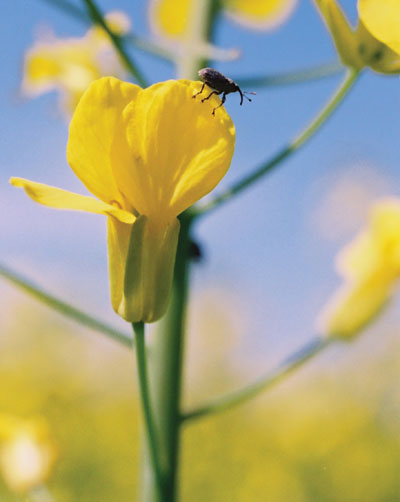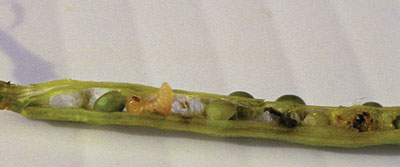
Features
Agronomy
Other Crops
Weevil-resistant canola coming soon
Another tool for controlling the cabbage seedpod weevil in canola will soon be available to growers.
November 21, 2011 By Carolyn King
Another tool for controlling the cabbage seedpod weevil in canola will soon be available to growers. A plant breeder and an entomologist have developed a weevil-resistant canola that will help protect yields, decrease insecticide application costs and reduce harm to beneficial insects. “The cabbage seedpod weevil initially arrived in North America in the Vancouver area, and then it dispersed southward into the US. It was first discovered in southern Alberta in 1995, and its population expanded dramatically once it hit the canola belt of southern Alberta. By 1999 we already had the very first serious weevil outbreak,” explains Dr. Lloyd Dosdall of the University of Alberta, who led the entomological component of this research.
 |
|
| The cabbage seedpod weevil has cost millions of dollars in yield losses and in insecticide application costs for Prairie canola growers. Photos courtesy of Dr. Lloyd Dosdall, University of Alberta. |
“The weevil has been damaging our canola crops substantially ever since, and there has been spraying for weevil populations virtually every year in southern Alberta and southern Saskatchewan. The weevil is spreading toward Manitoba and Saskatchewan much more rapidly than it is moving northward for some reason we don’t understand, but its range has continued to expand.”
The pest attacks the plant at several stages. Dosdall says, “The adults can feed voraciously on canola buds, preventing the buds from flowering and producing pods. The main damage occurs when the females lay their eggs into developing pods. The eggs hatch into larvae, and the larvae feed on seeds within the pods. This obviously helps to destroy yields. It can also provide an invasion pathway for fungi in some instances. And the infested pods are much more prone to shattering than uninfested pods. Then late in the season, when a new generation of adults emerges, they can feed on canola pods and cause further yield reductions.”
According to Dosdall, the cabbage seedpod weevil (Ceutorhynchus obstrictus) has cost millions of dollars in canola yield losses and in insecticide application costs for Prairie canola growers. “In bad infestations, you can lose 35 to 50 percent of your yield,” notes Dr. Laima Kott of the University of Guelph, who led the team working on the canola breeding component.
Along with reducing yield losses caused by the pest, the weevil-resistant canola reduces the need for insecticide applications. In areas with moderate weevil populations, the resistant canola would not need an insecticide application to control the weevil. In areas with very heavy infestations, even the resistant canola may have to be sprayed, but it would need less insecticide than susceptible canola.
Reduced insecticide applications not only save money for growers, but they also help beneficial insects, including pollinators and insects that prey on the weevil. “To use insecticide for weevil control, the crop needs to be sprayed just as it’s coming into flower. But as the crop comes into flower there are more and more beneficial insects in the crop. The insecticides are broad spectrum, so they take out everything, including the beneficial insects,” says Dosdall. His research team identified 14 species of native Alberta parasitic wasps that attack the weevil’s larvae in canola pods in southern Alberta.
A 10-year journey
“To put it simply, we’ve taken the resistant trait from a plant related to canola and we’ve put it into canola and made it work there,” says Kott.
That may sound easy, but the work took about 10 years.
 |
|
| The cabbage seedpod weevil larva feeds on canola seeds within a pod. Photos courtesy of Dr. Lloyd Dosdall, University of Alberta.. |
The researchers’ first step was to test many plant species in the same family as canola, specifically, the Brassicaceae family, for their ability to resist the weevil. Dosdall’s team grew the species in plots in southern Alberta under heavy weevil pressure and determined that Sinapis alba was very resistant to the weevil.
Sinapis alba, called white mustard or yellow mustard, is grown as a crop in southern Alberta and Saskatchewan for the condiment mustard market. This species has evolved to be resistant to several insects, including flea beetles, root maggots and cabbage seedpod weevils.
Kott outlines the next steps in the research. “I made a cross just as breeders do, taking the pollen off one and crossing into the other. If you cross white mustard with canola, it’s going to be 50 percent the genes of each, and it looks horrible. So we basically transferred some DNA from white mustard into canola, and then backcrossed to canola a number of times to make it look more like canola, but we’re hoping that it still carried some of the white mustard DNA. We tested every generation to see which lines the weevils avoided. Then we took the seed of those lines, grew them out and backcrossed them again to canola, bringing it back to the original canola genotype.”
She discarded any lines that were not canola quality in terms of glucosinolate and erucic acid levels (canola has much lower amounts of these compounds than rapeseed). Then she gave the rest of the lines to Dosdall to test under heavy weevil pressure at Lethbridge. In the initial round, he tested about 230 genotypes. About 17 of those had very low levels of weevil attack; that is, no more than five percent of the pods on these plants were getting attacked by the weevil and having weevil larvae develop in them.
During about a five-year period, roughly since 2007, the researchers narrowed those 17 lines down further and further to identify clearly resistant breeding material.
The University of Guelph, which owns the weevil-resistant breeding material, released it publicly in 2010. It is available to anyone who enters into a licensing agreement with the university. Kott says several breeding companies are working already with the material to add weevil-resistance into their own breeding lines. She speculates it may take about two or three years for these companies to have resistant canola hybrids ready for growers.
To help speed up development of resistant lines, Kott’s team is now working on identifying the molecular markers in canola DNA that are associated with weevil resistance. These markers would allow breeders to determine in just a few hours in the lab if a canola plant’s DNA includes the resistance trait, rather than having to seed the plant in the field and expose it to the weevils during the growing season.
The breeding component of this research was funded by the Natural Sciences and Engineering Research Council of Canada. The entomology component was funded by the Alberta Canola Producers Commission, the Canola Council of Canada and the Alberta Agricultural Research Institute.
Quadruple whammy
Dosdall was curious to learn what it is from the weevil’s point of view that makes this canola resistant. He says, “When a weevil is looking for a plant that might be a host or might not, it zeros in using vision from long distances, then when it gets closer it uses odour, and then when it lands it uses touch and taste.”
Dosdall’s team conducted tests to evaluate all these aspects. They found that the resistant canola deters the weevil in four ways. The researchers allowed the male and female weevils to see the resistant and susceptible plants without being able to smell them. The weevils were much more attracted to the susceptible canola.
The researchers also exposed the weevils to the odour of the susceptible and resistant plants, without any visual input. Again the weevils preferred the susceptible lines. Then the researchers offered the weevils a choice of pods for laying their eggs. Dosdall notes, “If the weevil has a choice of pods, it will first walk up and down the pod and stroke its sensilli on its feet to pick up taste molecules and it will also probe the pod with its mouth parts. The weevils chose to lay eggs on pods from susceptible plants much more so than on pods from resistant plants.
“So there’s a visual difference, an odour difference, and a taste difference between the resistant and susceptible plants. And we also found that there’s a toxin effect hampering weevil development. If you force the weevils onto our resistant canola and don’t give them any other choices of where to lay their eggs, their larvae take longer to develop and when they are mature, they weigh a lot less.”
Kott thinks these weevil-repellent effects may be due to high levels of certain glucosinolates in the resistant plants. “There are over 150 different kinds of glucosinolate compounds, and all the members of the Brassicaceae family, like cabbage, canola, mustard and broccoli, have glucosinolates, but canola has been bred to have very low levels,” she explains. Her team transferred a little more of two kinds of glucosinolates from white mustard to canola; just enough to make the canola resistant to the weevil.
She says the levels of the two glucosinolates peak at two key stages. “One is when the female weevil is flying around saying, ‘Is this a good place to lay my eggs or not?’ If she smells the wrong kind of glucosinolates, she won’t lay her eggs there. If she doesn’t smell them, she’ll lay her eggs there. And an increase of the other glucosinolate turns up during the early development of seeds inside a pod.
And if there is a larvae in there, it’s going to die because it doesn’t like this stuff.”
Novel approach to insect control in canola
This research represents a new direction for insect pest control in canola. Dosdall notes, “Canola is grown in many different countries and continents, like Australia, North America, Europe and Asia. If you look at the top pests and look at the top ways of controlling them, in every country it’s always insecticide. We do have other control strategies, like cultural practices, but now there’s a real opportunity for something other than insecticide as a main control strategy for a top pest.”
He adds, “In the past when researchers have developed insect-resistant crops, it’s been by adding a gene from a bacterium to code for a toxin that kills insects, like Bt cotton and Bt corn. But we haven’t used any foreign genes; we’ve used a rather routine plant breeding approach to obtain resistance.”
Kott says, “The resistance is now built into the canola genotype. It’s there from a natural source, not from a spray. So economically it’s good for the farmer; he either doesn’t have to spray at all or not so much spray is needed. Second, it’s healthier for people and the environment because we are not spraying. And third, the grower gets a better yield. Those are just three advantages, and they are pretty good ones!”